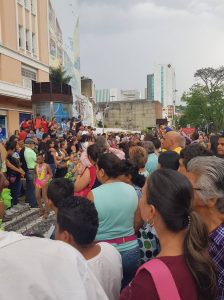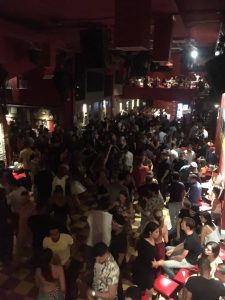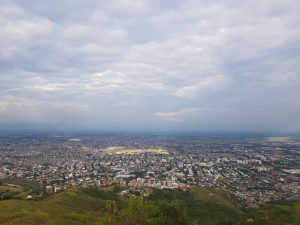
Desfile infantil de salsa, Cali
Viva la salsa colombiana. Gracias por hacernos felices.
“Es un misterio por qué todas las celebraciones y visitas que involucran colombianos, terminan con la mesa de centro a un lado para dar espacio a la pista de baile.”
[Mónica Corredor, periodista colombiana]
Antes de ir a Colombia, mi universidad me advirtió sobre las dificultades potenciales de vivir en otro país, dándome consejos sobre el manejo del llamado “choque cultural” que seguramente iba a padecer en algún momento de mi estancia en el extranjero. Igualmente, al llegar el día de inducción de la Universidad de Los Andes, asistí a charlas que hablaron sobre los desafíos de vivir en una nueva ciudad que tiene problemas de seguridad y donde la gente habla otro idioma.
Sin embargo, solo ahora, al empezar mi tercer mes aquí, me doy cuenta de que lo que Colombia me ha provocado no ha sido un choque cultural como tal, sino algo mucho más espantoso, una crisis existencial: aquí me percaté por primera vez de que nunca en mi vida hasta ahora he aprendido bailar.
Tal vez la revelación mas profunda, y indudablemente la más maravillosa de mi tiempo en Colombia hasta ahora ha sido la salsa. Aunque sí, el ají ha sido un descubrimiento genial, a lo que me refiero es el baile: el ritmo hegemónico de Latinoamérica y el Caribe, con raíces afrocubanas y puertorriqueñas.
Un viaje a Cali, un verdadero fortín del género y la sede del Festival Mundial de Salsa, me inspiró a tomar clases para principiantes en la universidad, donde Mauricio, un bailarín virtuoso y profe súper-entusiasmado, nos enseña pasos, agarres y vueltas que son cada semana más difíciles. (Mi consejo es ¡ojo con la palabra “principiantes”, porque un “principiante” colombiano no es igual a un principiante europeo!) Lo bueno es que Mauricio siempre resalta que las clases no son un fin en sí sino que nos facilitan a disfrutar de la salsa en su entorno natural – la fiesta.
Con este consejo en cuenta, durante mi tiempo en Bogotá he intentado realmente “vivir” la salsa colombiana, y cada miércoles, con un “buen parche”, frecuentamos el Rincón cubano – un bar de salsa con mesas arregladas en torno de la pista de baile. Y cada semana, sin excepción, me duermo murmurando conmigo mismo el compás salsero que es fundamental al bailar al ritmo – “un(o), dos, tres…cinc(o), seis, siete.”
Confieso que no demoré en hacer caso de que saber bailar era un requisito para dejar admiradas las chicas. El poder inmenso y misterioso de la salsa en encantar a una mujer ha sido un descubrimiento muy esclarecedor y ¡tal vez por eso siempre asistan más hombres a las clases que mujeres!
Sin embargo, independientemente de su rol en coquetear, la cultura de bailar en pareja – algo que se hace poco cuando salimos de rumba en el reino unido – crea una conexión positiva entre individuos, sea amigos o desconocidos, y desencadena endorfinas que mejoran nuestro humor. Colombia es un país que frecuentemente aparece entre los países más felices del mundo, un hecho que choca con su historia de conflicto armado y sus altas tasas de desigualdad y delincuencia. Aunque es posible que la alegría colombiana sea un poco falsa, si hay una explicación de la felicidad del pueblo, de pronto se encuentra en la cultura de rumba y baile tan prominente en el país. Según un amigo mío, Yesid, quien lo entrevisté sobre el asunto de la alegría colombiana para un proyecto universitario, “la alegría siempre une al pueblo colombiano y la gente siempre se une en torno a la fiesta. Siendo diferentes pero vivir en espacios donde podemos disfrutar hacen construir un país más fuerte, una unidad cultural grande.” Aunque perezcan lugares triviales, bares salseros como el Rincón cubano, ofrecen espacios importantes para encadenar a la gente sin importar sus diferencias. Y sobre todo en una metrópolis desconectada y a veces hostil, como Bogotá, resulta que estos lugares sean indispensables.
A la luz de la afirmación de Yesid, la salsa colombiana tiene un valor social más allá de solo diversión. Une al pueblo y su ubicuidad por todo Colombia la hace un rasgo importante de la identidad nacional de un país heterogéneo y regionalista. Canciones salseras como “El preso” de Fruko y sus Tesos o “Oiga, mire, vea” de Guayacán Orquesta son reconocidas a lo largo y ancho del país y las letras de la ultima atestan al aporte de la salsa en inspirar felicidad en el pueblo:
“Aquí no hay problema,
Aquí no hay pelea,
Mi gente de Cali,
Disfruta y rumbea.”
Aunque la asociación entre América Latina y lo carnavalesco ha sido uno de los varios estereotipos del continente, creo que la cultura de baile, sobre todo en festivos populares y fiestas, ha creado cierta realidad carnavalesca. El baile provee un punto de encuentro de varias clases, razas y edades, permitiendo una subversiva interacción de individuos, y además, crea un espacio de excentricidad y libertad, un foco de escape y diversión. Tal vez esto explica por qué, “todas las celebraciones y visitas que involucran colombianos terminan con la mesa de centro a un lado para dar espacio a la pista de baile.”
Los colombianos también son culpables de estereotipar a los europeos como gente fría, seria y tiesa, señalando que, a diferencia de los latinos, no sabemos como “farrear” o pasárnoslo rico. Corroboro que también hay un grado de verosimilitud frente a esta acusación, y estimo que la causa principal de la sobriedad británica al menos es la ausencia de baile en nuestras vidas.
La transmisión intergeneracional de la salsa en el hogar familiar implica que este genero corre, literalmente, en la sangre de los colombianos y la disposición aparentemente genética de bailar es innegablemente una causa de la calidez y alegría de la gente aquí. Para terminar, cito al periodista colombiano Ernesto Armenteros: “viva la salsa colombiana. Gracias por hacernos felices.”

La Topa Tolondra – bar salsero de Cali
Viva la salsa colombiana. Thanks for making us happy.
‘It’s a mystery why all celebrations and visits involving Colombians, finish with the table to one side in order to give space to the dance floor.’
[Mónica Corredor, Colombian journalist]
Before going to Colombia, my university warned me about the potential difficulties of living in another country, giving me advice about managing the so-called ‘culture shock’ that I was surely going to undergo at some point during my stay abroad. Equally, upon arriving at la Universidad de Los Andes’ orientation, I attended the normal talks about the challenges of living in a new city, with a different language and security problems.
However, only now, upon starting my third month here, I realise that what Colombia has provoked in me hasn’t been a culture shock as such, but rather something much more horrifying, in the form of a certain existential crisis: here I realised for the first time that, never in my life until now, have I learned to dance.
Perhaps the most profound revelation, and undoubtedly the most marvellous of my time in Colombia up till now has been the salsa. Although it’s true that the condiment ají has been a great discovery, what I refer to is the dance: the hegemonic rhythm of Latin America and the Caribbean, with afro-Cuban and Puerto Rican roots.
A trip to Cali, a true fortress of the genre and host of the World Salsa Festival, inspired me to take beginners classes in the university, where Mauricio, a virtuoso dancer and super-enthusiastic teacher, teaches us steps, holds and spins which are harder and harder each week. (My advice is watch out for the word ‘beginners’ since a Colombian beginner is not the same as a European beginner!) What’s good is that Mauricio always emphasises that the classes aren’t an end in themselves but rather a means of facilitating us to enjoy salsa in its natural environment- the fiesta.
With this advice in mind, during my time in Bogotá I’ve tried to really ‘live’ Colombian salsa, and each Wednesday, with a good bunch of mates, we frequent Rincón Cubano (‘Cuban Corner’), a salsa bar with tables arranged around a dance floor. And each week, without exception, I fall asleep murmuring to myself salsa’s dancing rhythm which fundamental to staying in time: ‘un(o), dos tres…cinc(o), seis, siete.’
I confess that it didn’t take me long to realise that to know how to dance is a requisite for impressing the ladies. Salsa’s immense and mysterious power to charm a woman has been a very enlightening discovery and perhaps this explains why there are always more men in the classes than women!
However, regardless of salsa’s role in ‘the chase,’ the culture of dancing with a partner – something which doesn’t come naturally to most Brits – creates a positive connection amongst individuals, be it friends or strangers, and releases endorphins which improve our mood. Colombia is a country which frequently features amongst the most happy countries in the world – a fact which clashes with its history of armed conflict and high rates of inequality and crime. Although it’s possible that Colombian happiness might be a little false, if there is an explanation for the people’s happiness, perhaps it is to be found in the culture of dance and fiesta that is so prominent in the country.
According to my friend Yesid, who I interviewed as part of a university project on Colombian happiness, ‘happiness always unites Colombians and people always come together for the fiesta. Being different but living in spaces where we can have a good time helps to construct a stronger country and an important cultural unity.’ Although they may seem like trivial places, salsa bars like Rincón Cubano, offer important spaces to connect people regardless of their differences. And above all, in a disconnected and at times hostile metropolis like Bogotá, these sorts of places become indispensable.
In light of Yesid’s affirmation, Colombian salsa has a value beyond just entertainment. It unites the people and its ubiquity throughout all of Colombia makes it an important feature of the national identity of a heterogenous and regionalist country. Salsa hits like Fruko y sus Tesos’s ‘El preso’ or Guayacán Orquesta’s ‘Oiga, mire, vea’ are recognised across the length and breadth of the country and the lyrics of the latter attest to salsa’s contribution in inspiring happiness in the people:

Cali, tercera ciudad de Colombia y capital del departamento de Valle de la Cauca

Estatua de Cristo Rey, Cali
‘Aquí no hay problema,
Aquí no hay pelea,
Mi gente de Cali,
Disfruta y rumbea.’
‘Here there’s no problems,
Here there’s no fighting,
My people of Cali,
Enjoy and get dancing.’
[my (improvised) translation]
Although the association between Latin America and the carnavalesque has been one of the stereotypes of the continent, I think that the dance culture, above all in popular festivals and parties, has contributed to a certain carnavalesque reality. Dance provides a meeting point for various races, classes and ages, permitting a potentially subversive free interaction amongst individuals, and moreover, it creates a space of eccentricity and freedom. Perhaps this explains why ‘all the celebrations and visits which involve Colombians finish with the table to one side to give space to the dance floor.’
Colombians are also guilty of stereotyping Europeans as cold, serious and rigid, pointing out that, compared to Latinos, we don’t know how to party or have a good time. I can corroborate that there is also a certain degree of truth to this accusation, and believe that the principal cause of British sobriety at least, is the absence of dance in our lives.
The intergenerational transmission of salsa in the family home means that this genre runs, quite literally, in the blood of Colombians and the apparent genetic disposition to dance is undeniably a cause of the warmth and happiness of the people here. To finish by quoting Colombian journalist Ernesto Armenteros: ‘viva la salsa colombiana. Thanks for making us happy.’
